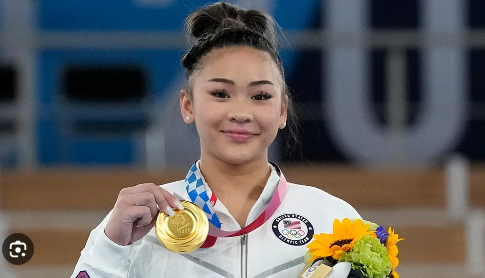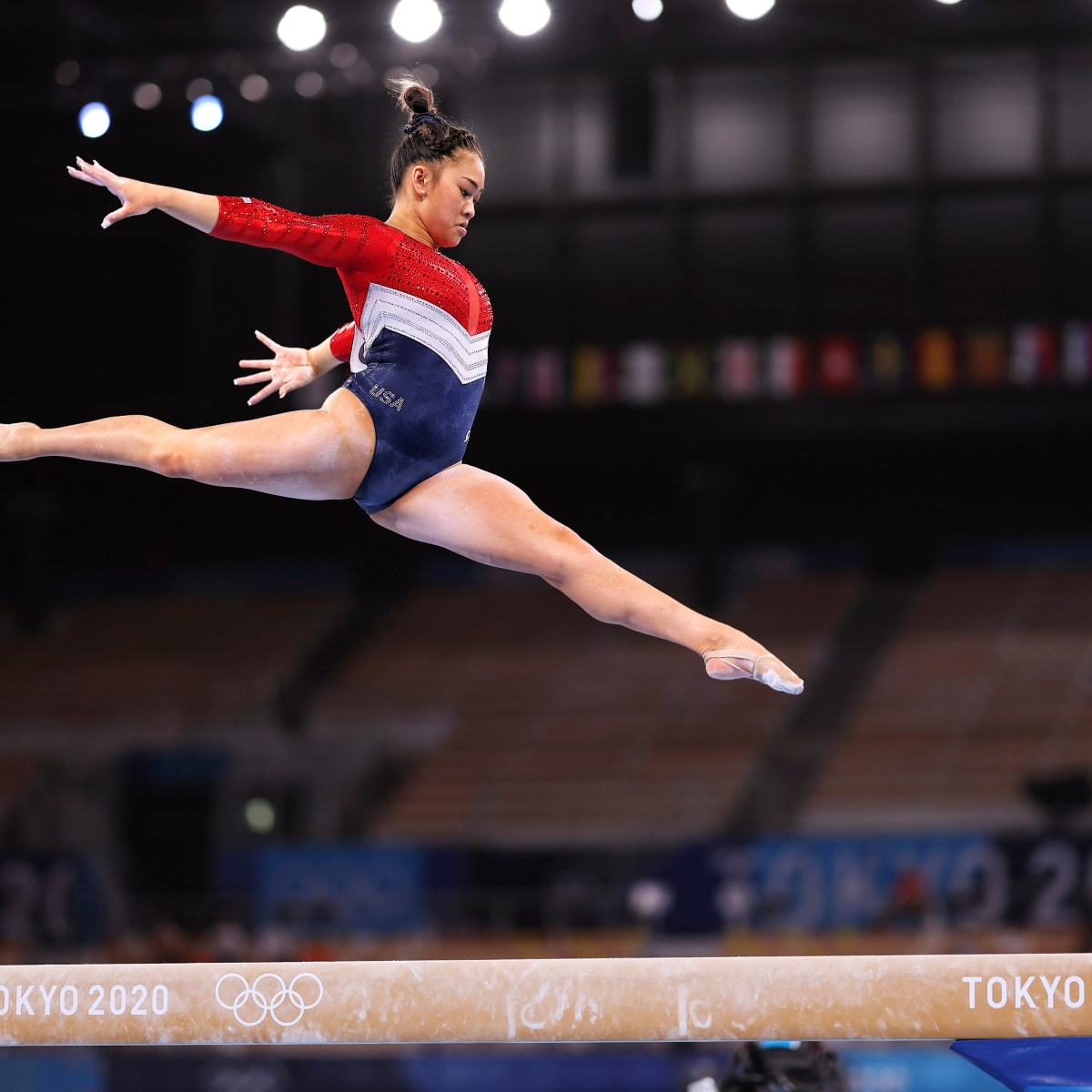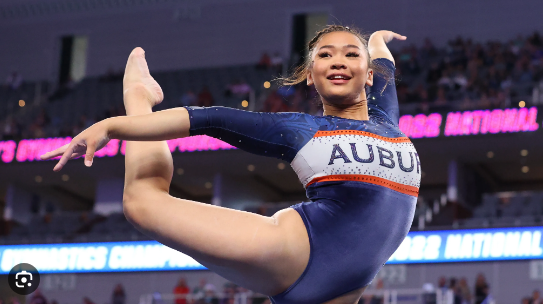The Olympic champion on her newly diagnosed kidney condition, her path to the 2024 Games, and the pressure to live up to her past self.
Sunisa Lee was nervous. Actually, she was more than a little nervous. She told her coach Jess Graba that she was panicking.
Who could blame her? Lee, who commonly goes by Suni, was about to compete at the Core Hydration Classic in early August. It was her first elite gymnastics meet in two years, and she didn’t feel totally prepared. That alone would be enough to stir up anyone’s nerves, but there were other factors weighing heavily on her before the competition in Chicago.
For the first time in years, Lee needed to qualify for the US Gymnastics Championships. She had already publicly stated that she has her eyes set on 2024’s Paris Olympics. If she missed out on the championships, she’d be behind the proverbial eight ball, influencing her chances of securing one of five roster spots on Team USA. As the reigning individual all-around champion—she had earned the best combined score on the vault, uneven bars, balance beam, and floor exercise during the Tokyo Olympics in 2021—Lee felt like she had to perform flawlessly. But earlier this year she was diagnosed with a kidney disease that cut short her NCAA gymnastics season with Auburn University, where she had competed for two years. The condition has kept her from training consistently for the last six months.
Graba knew that Lee was under enough pressure and didn’t tell her the score required (26.4 points) to clinch a spot for the national meet. They had prepared routines for three events—beam, vault, and bars—with a lower level of difficulty than Lee is typically used to. She didn’t need to overdo it. Solid scores in her first two rotations would move her through, but a mistake on either apparatus would be a test, both physically and mentally.
So Lee was nervous. How would it feel to compete at the elite level again? Would she meet everyone’s expectations, including her own? Most importantly, would her body execute the flips and leaps she needed to secure a sufficient score?
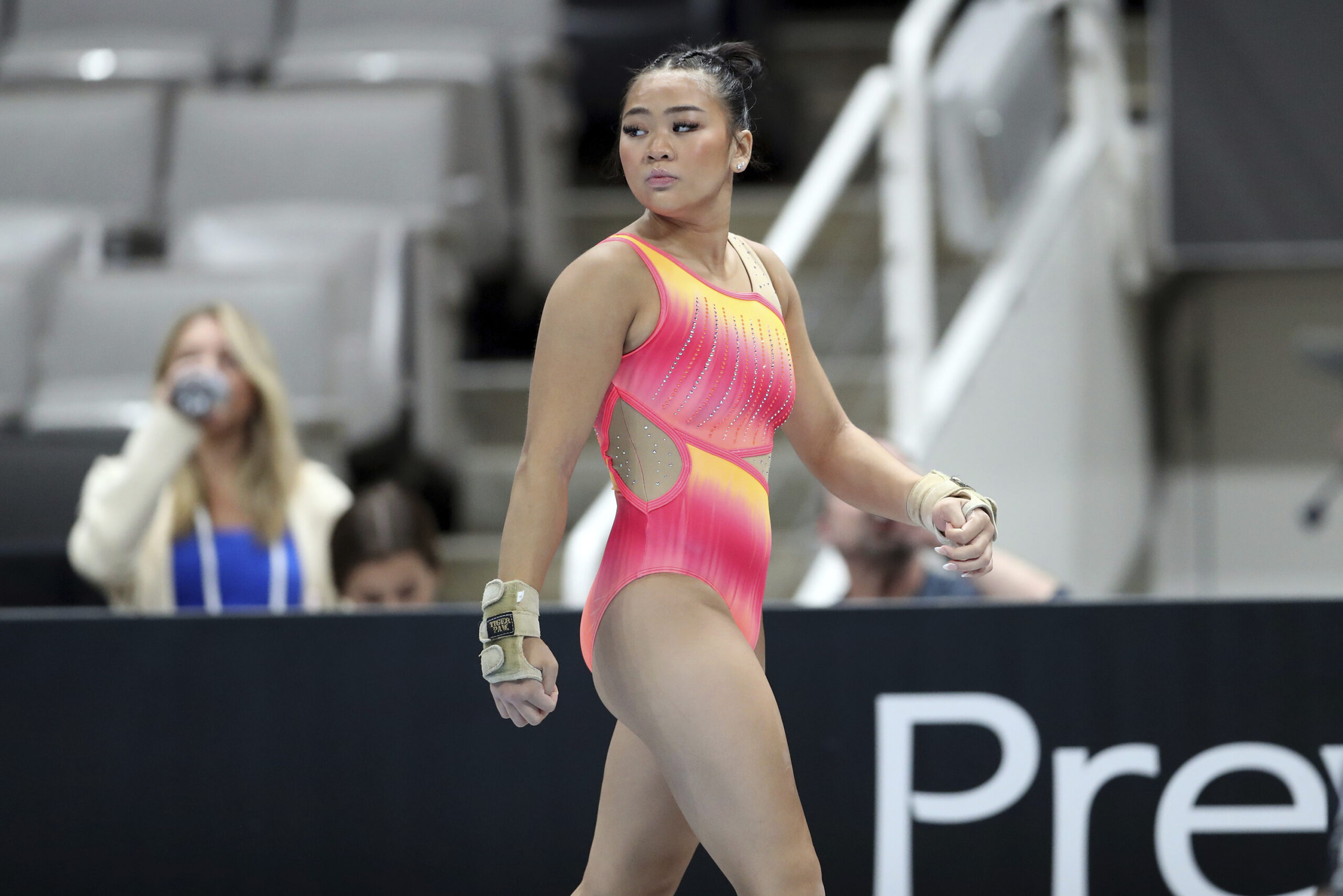
Wearing a sparkly lavender-and-gray leotard, Lee mounted the beam. Adrenaline coursed through her body—and then she let go. In the following 75 seconds, she smoothly connected dance elements and acrobatics along the four-inch-wide beam. She dismounted with a small hop, threw her arms up in the air, and smiled as the crowd roared. She embraced her coaches and USA Gymnastics team physician Marcia Faustin. As tears streamed down her face, she let out a deep breath.
Her score of 14.5—the second-highest score on beam that day—along with a 13.5 on vault placed her well within the range of qualifying for the US Championships. Her night was over; she didn’t even need to compete on the uneven bars.
Lee knew it would be an emotional experience. A couple of months before this competition, “we didn’t think that I would be here. We didn’t know what was possible. We didn’t know what was wrong with me,” Lee tells SELF. She didn’t think she’d ever do gymnastics again. “And here I am on the big stage, competing.” It was surreal.
In the last four years, the 20-year-old St. Paul, Minnesota, native has faced many pivotal moments. She has emerged as one of the best gymnasts on the planet and catapulted to stardom after Tokyo. She’s juggled newfound fame, including a stint on Dancing with the Stars and appearances at the ESPY Awards and Met Gala. She’s the first all-around gold medalist to compete in NCAA gymnastics and capitalize on her name, image, and likeness. And as the first Asian American to win the Olympic all-around title, she’s become an even bigger role model for girls in sports, especially within the Hmong community.
These big moments come with big expectations and immense pressure. It can feel like you’re standing on a moving walkway and there’s only one direction to go. For Lee, everything points toward competing at the Olympic trials in her hometown of the Twin Cities next summer and making a return trip to the 2024 Summer Games.
But she also has a chance to redefine the path ahead of her, to redefine herself. She knows that she’s more than just her sport. It’s something her teammates at Auburn reminded her of. “They’re like, ‘We don’t care if you’re the Olympic champion. We just want Suni,’” she says.
And Suni Lee is reminding herself that she is enough.
When you walk into an elite gymnastics gym, there’s a lot of sensory information to process. Blue mats. The metal whine from the uneven bars. Chalk dust filtering through the air. When I ask Lee about the first thing that comes to mind when she thinks of the gym, her answer is not what you might expect. “It smells like feet when you walk in,” she says, which she admits is kind of gross. “But I’m so used to it. That’s my home.”
Lee got her start in gymnastics like many kids: She was a high-energy child who used to tumble around her home in St. Paul. Her dad, John Lee, was her partner in crime. He taught her how to do backflips and built a wooden balance beam for her in the backyard. But she needed a greater outlet.
At six years old, Lee entered the sport “late” and had some catching up to do, which included cleaning up her technique and acclimating to a structured program at Midwest Gymnastics in Little Canada, Minnesota. She spent 8 to 12 hours a day either training or doing schoolwork at the gym.
It turned out that Lee didn’t just have extra energy to spare. She had prodigious talent and progressed quickly through USA Gymnastics’ Women’s Development Program, a 10-level system in which each tier represents progressively advanced skills and competition opportunities. In her first year of competing, at age seven, she won the all-around at a state meet—her second competition ever. The following year she jumped three levels. At age 11 she qualified for the elite program, the stage after level 10 that signifies athletes’ eligibility to represent the US in international competition. She was named to the Junior National Team at 14, and at 18 she won the Olympic all-around gold medal, helped lead the US to a team silver, and picked up a bronze for her performance on the uneven bars in Tokyo.
“What stands out about Lee is the fluidity and quality of her movements,” Dvora Meyers, a sports journalist and the author of The End of the Perfect 10, tells SELF. “Lee is a master of connecting one skill to the next, particularly on the uneven bars, and she does this in unexpected ways.”
But the gym wasn’t just a place for Lee to burn off pent-up energy and experiment with “crazy skills,” as she puts it. It was her refuge too. In order to perfect her gravity-defying routines, Lee needed to focus, which meant leaving her problems at the door. Plus, she finds moving her body up and around the different apparatuses to be cathartic. “Sometimes I’ll imagine the bar being my anger, and I’m chucking it off or something,” she says.
Lee’s first year of collegiate gymnastics was also a resounding success. She helped Auburn advance to the final four of the 2022 NCAA Women’s Gymnastics Championships for the first time and won the NCAA title in beam. But she wasn’t finished chasing her Olympic dreams. In November she announced that the 2023 season would be her last one competing for Auburn. She wanted to savor it all—the dynamic environment, the cheering, the laughs, her teammates. During the first half of the season, she shined, winning multiple events and one all-around title and finally scoring a 10 on bars at a home meet.
So when Lee woke up with swollen ankles in February 2023, she didn’t think anything of it at first. She is a highly competitive gymnast. Of course her ankles swell from time to time. But the next morning, everything was swollen—her face, hands, and legs. Her whole body. It was as if she’d gained several pounds overnight. This cannot be normal, she thought.
Lee wasn’t sure what to do, so she went to the gym because, well, she always goes to the gym. But she also knew her elite coach, Jess Graba, who was in town, would be there. As soon as she arrived, Graba asked her what happened. “I was like, ‘I don’t know!’” she recalls. Immediately they called Dr. Faustin, co-head team physician for the USA Gymnastics Women’s National Team. “The first thought was, How do we figure out the answer, and who do we need to speak to?” Dr. Faustin tells SELF. Since she was at the gym and had the reassurance of Graba by her side, Lee wanted to see if she was capable of training at all, given her physical condition. “I kept peeling off the bar. I couldn’t hold on,” she recalls. “My fingers were so swollen, and I couldn’t even do a normal kip cast to handstand on bars.”
Initially her doctors thought she experienced an allergic reaction, but the swelling didn’t subside, even after two weeks. “I just kept getting more swollen…and I think I gained, like, 40 pounds,” Lee says. When she finally had to sit out during an away meet against Kentucky the first weekend in March, she knew she wasn’t dealing with allergies, but she still had no idea what, exactly, was happening. “It affected my whole body and how I looked and how I was feeling,” she says.
Her teammates could see that something was going on, but she didn’t feel comfortable confiding in them for fear of rumors spreading around campus or in the media. She didn’t want to go out in public because she didn’t feel well or look like herself, yet she had to show up at meets. She didn’t tell her mom right away either. “I knew she would freak out, and I was already really stressed,” Lee says. The worst part? She couldn’t go to the gym to work out her emotions. In March, the feathery pink dress and glitzy, strappy heels she wore on her birthday belied the sadness she felt inside. “What if I’m never allowed to do gymnastics again or I can never make it to the Olympics again?” she wondered.
Her doctors conducted multiple tests to try to rule out different conditions but came up empty-handed. Lee continued to update Dr. Faustin, who helped her navigate the medical system and lent a sympathetic and supportive ear. During one of their conversations, Dr. Faustin asked Lee if the doctors had run a urine test, a routine procedure for a person experiencing the symptoms Lee had. But Lee hadn’t taken one and admitted that she had been having trouble peeing for two weeks. That’s when her medical team realized that she could be dealing with a kidney issue. They ran labs, which suggested that she needed further testing. Finally she was referred to a specialist who recommended a biopsy to examine samples of her kidney tissue for signs of damage or disease.
About a month after Lee woke up with a body that didn’t feel like her own, her doctors shut her down from training and competing, and on April 3, Lee announced she was ending her sophomore season early due to a “non-gymnastics health-related issue involving my kidneys.”
The kidneys, the two bean-shaped organs located below your rib cage on both sides of your spine, are each made up of roughly a million nephrons—microscopic tubes with mini filters that are critical for keeping the body’s fluid and mineral content balanced and blood pressure controlled. Blood flows into a cluster of tiny blood vessels called the glomerulus, which removes waste and excess water from the blood. Those filtered substances then become urine.
With a condition like Lee’s, the kidney tissue can eventually show signs of injury and scarring. “When scarring [on the kidneys] occurs, it tends to become a bit of a vicious cycle,” Debbie Gipson, MD, the program director in the Division of Kidney, Urologic, and Hematologic Diseases at the National Institute of Diabetes and Digestive and Kidney Diseases, tells SELF. “The body is reacting to that injury and injury begets injury.” As the kidneys’ filters become inflamed or damaged, it becomes harder for the organs to clear waste and excess fluid from the body, Dr. Gipson, who isn’t treating Lee, explains. When that happens, blood and protein can leak into urine, and symptoms like swelling and fatigue can manifest.
Lee has shared the name of her current diagnosis with SELF off the record, but her medical team believes it may change as they continue to understand what’s going on inside her body, so she is keeping it private for now. While more than one in seven people may develop chronic kidney disease in their lifetime, Lee’s condition isn’t common, and there is no cure yet. Treatment typically involves a medication regimen to help manage symptoms, but Lee’s care plan is a work in progress.
As an elite athlete, Lee’s body is her instrument. There’s an intimacy and awareness borne from years spent testing her limits and becoming extremely familiar with every nook and cranny, every strength and weakness. Now, overnight, her body felt completely foreign. She was supposed to be getting ready for the postseason. She was supposed to be celebrating her final collegiate season. She was about to turn 20. Instead, she wondered, What’s wrong with me?
While Lee says it feels good to have a better idea of what’s going on with her health, to know that there could be a path to getting better, a diagnosis also solidifies that something is wrong. It was a heartbreaking and confusing realization that left Lee in denial: “How do I just randomly wake up one day swollen, and now I’m stuck with this condition for the rest of my life?”
For an athlete, it can feel like you’re only as good as your last result, and Lee has talked about her struggles with imposter syndrome. Last year she told ESPN that it’s been hard to live up to the gold-medal standard, saying, “There’s just been so much doubt in like, ‘Oh, she shouldn’t have won [the] Olympics, blah, blah, blah,’ and it really hits my soul.” It’s part of why competing in Paris next summer means so much to her: It’s a chance to prove that her success wasn’t a fluke. Lee wants to win gold in her signature event, the uneven bars, and in the team event. Repeating as all-around champion? “That would be amazing,” she says.
Those are lofty goals, and Lee admits that she wonders if she’s capable of it all. “I look at myself all the time in videos, and it makes me emotional because I’m just not the same athlete I was before,” she says—before Tokyo, before her kidney issues. It doesn’t help that former all-around champ Simone Biles is also making her comeback. “I feel like my mindset switched to the way it was before, where I’m like, Okay, now I’m just competing for second,” she says, referring to the sentiment that whenever Biles is on the floor (or the beam, bars, or vault), everyone else is vying for silver. “Sometimes you don’t think that you’re even capable of winning anymore.” (Lee is also quick to praise Biles, whom she’s friends with, and says having Biles back in the arena motivates her to be a better athlete.)
No one would blame Lee if she stepped away from the sport. She’s a young, elite gymnast who works tirelessly at her craft but can’t train the way she’s used to, sowing doubt in herself and her abilities. Lee has asked herself if it’s worth putting her body through the rigorous training that’s required to represent Team USA when there’s still so much unknown about her health. That’s part of the reason why she was hesitant to publicly discuss her condition in the first place, and why she was “scared to put a leotard on for the first time again.” She doesn’t want to put herself down, but sometimes she worries that people will dismiss her because of her condition and assume there’s no way she can compete in the Olympics.
But she realized that her story might help someone. “This comeback was so much more than my return to elite gymnastics. It was me proving to myself that I can overcome hard things, and to hopefully inspire others to never let life’s setbacks stop you from going after your dreams,” Lee wrote on Instagram in August.
Her message is a reminder for anyone facing health challenges as well as the broader community of girls and women in sports, especially in the Hmong community, in which Lee has noticed girls tend to take on more traditional roles at home. “That’s why I want to help pave a way for other women,” she says. She doesn’t mean that everyone should do gymnastics. Rather, she wants to encourage people to find something that is meaningful to them and that brings them joy, and to not give up on themselves.
Lee still loves gymnastics, but this year has compelled her to reexamine her relationship with the sport. She’s been forced to work with her body as it is now—not how it used to be or how she wishes it was—and make sure she’s as safe as possible when she practices and competes. “Suni and her coaches have really embraced the fact that it’s not going to be like 2021,” Dr. Faustin says. “She has to listen to her body and…have this awareness and confidence in herself to adjust and to move training how she needs to, based on how she’s feeling and other factors.”
The tricky thing is that those factors are constantly shifting. Lee still experiences swelling, usually every day, but it’s unpredictable, coming and going at different hours. Sometimes she’s woken up with her eyes swollen shut. Other times her hands have been so swollen that she couldn’t fit them into her grips. She’s been hit with hot flashes and cold spells, headaches, and cramping, which is tough to train through. The medications she’s taking aren’t easy on her body either.
“We’re just trying to adjust to it and still learning how to work through it,” Lee says. Her kidney specialist, along with USA Gymnastics physicians, regularly monitors her symptoms, vitals, lab work, and potential side effects to guide her treatment plan. They keep tabs on other factors that might affect an elite athlete, like optimal hydration, and ensure that her medications don’t violate anti-doping regulations. They’re also helping her build new skills and habits to stay as healthy as possible, such as eating more frequently during the day and watching her salt intake, since high sodium levels can affect kidney function. (Yep, that means no more pickles during meets to ward off cramping.)
For most people with kidney disease, a big goal is to be able to take care of themselves independently. Dr. Faustin acknowledges that that could be Lee’s goal, but it wouldn’t be her normal. A thriving Suni Lee expertly performs somersaults and flips, handstands and twists, and high-flying acts on the bars.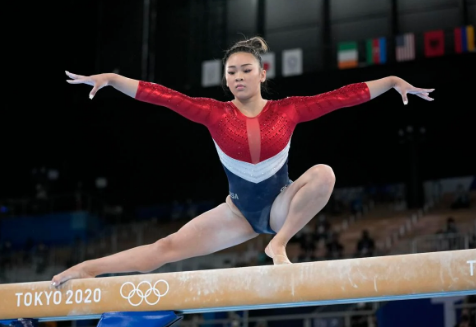
With careful guidance from her medical team and coaches, she aims to train twice a day on Mondays and Wednesdays and once a day on Tuesdays, Thursdays, and Fridays. But what her day actually looks like depends on how she feels. On good days she takes advantage of her time in the gym, working on beam, bar, or vault routines. On bad days she focuses on the basics: dance elements, turns, even just jumping on the trampoline.
The inconsistency, however, makes it hard to build stamina and endurance, which she needs to confidently compete. Lee was invited to last month’s US Women’s World Selection Event—a two-day camp competition that determined the athletes who would represent Team USA at the World Artistic Gymnastics Championships in Belgium this week—but she declined to participate. The difficult decision was a matter of “staying true to myself rather than pushing myself and not being satisfied with the results,” she said in an interview in late September. “My health is more important, and I’m not in the best shape right now.”
She admits she’s nervous heading into this Olympic cycle, but she’s taking it day by day and trying not to get too hung up on the idea of perfect scores or medals. She also recognizes that she needs to protect her whole self, starting with her mental health. “If I just keep pretending it’s not happening, then it’s just going to deteriorate by the time I’m actually at the Olympics, if I make it,” she says. That means controlling what she can actually control—taking a break from social media, seeing a therapist twice a week, and moving home to Minnesota to be closer to family, friends, her coach, and her medical specialists at the Mayo Clinic. She’s recording herself in the gym as a way to keep track of her progress and build confidence. She also got a puppy, an Australian Shepherd named Bean, who she says has helped the most.

